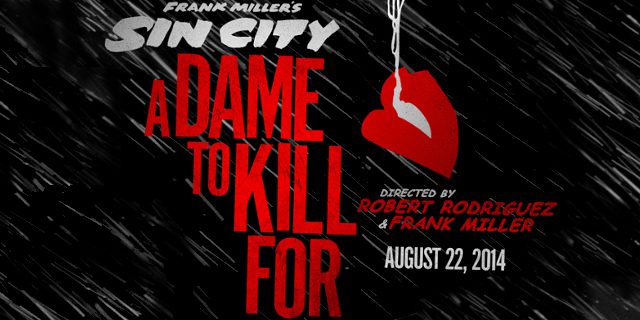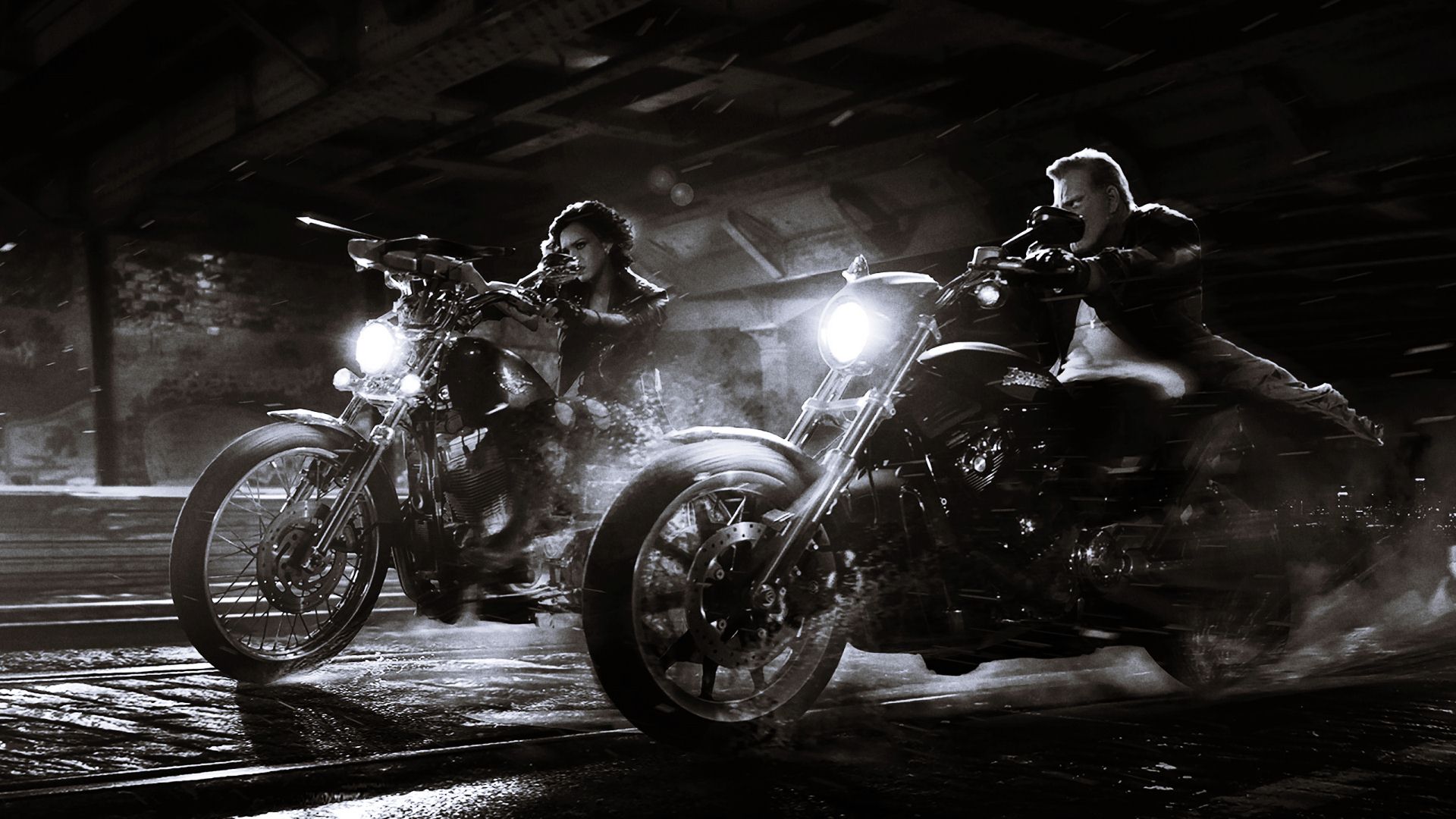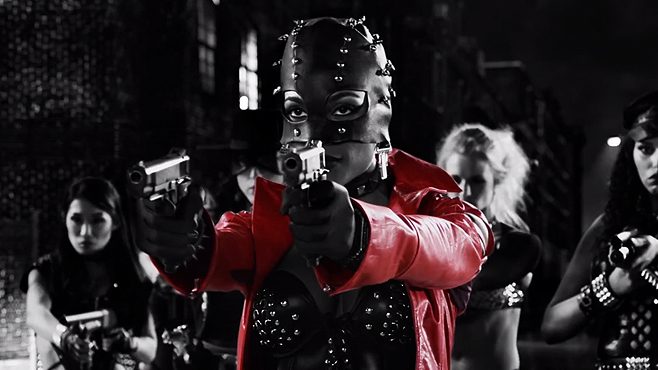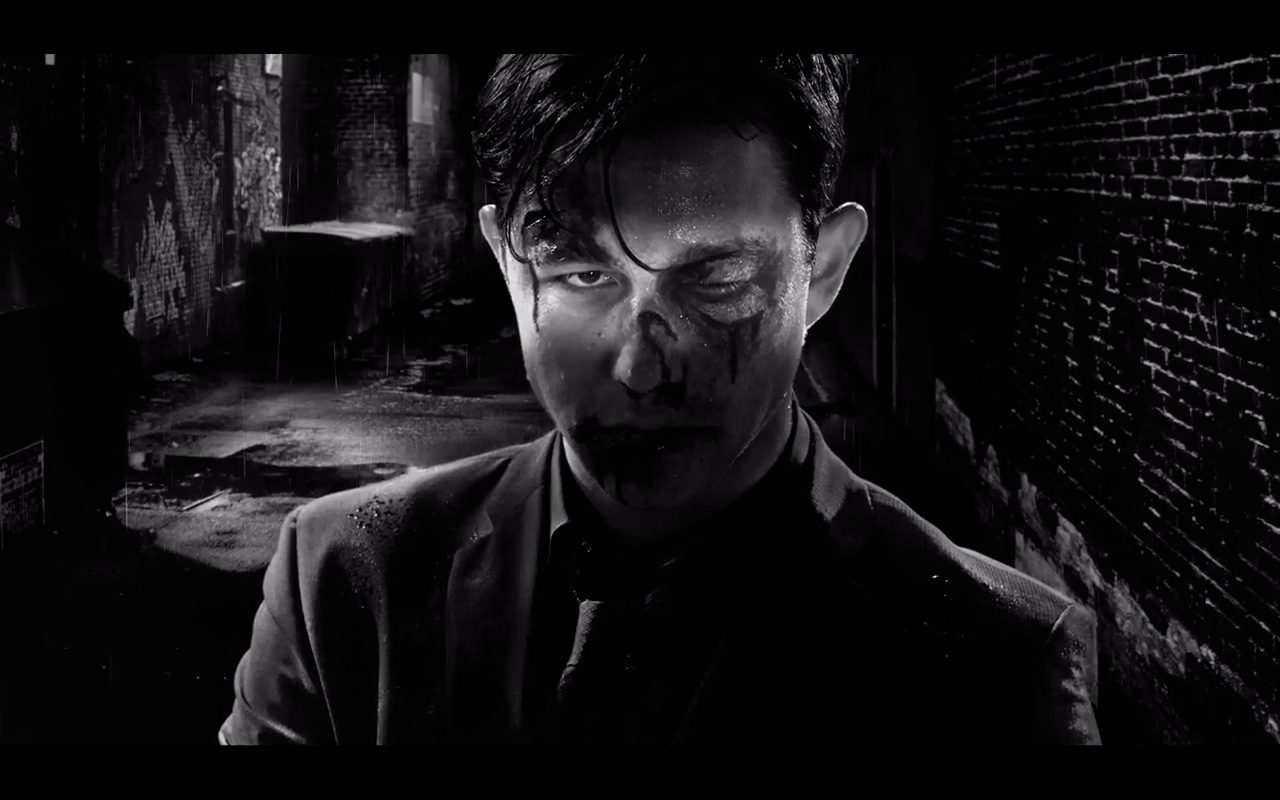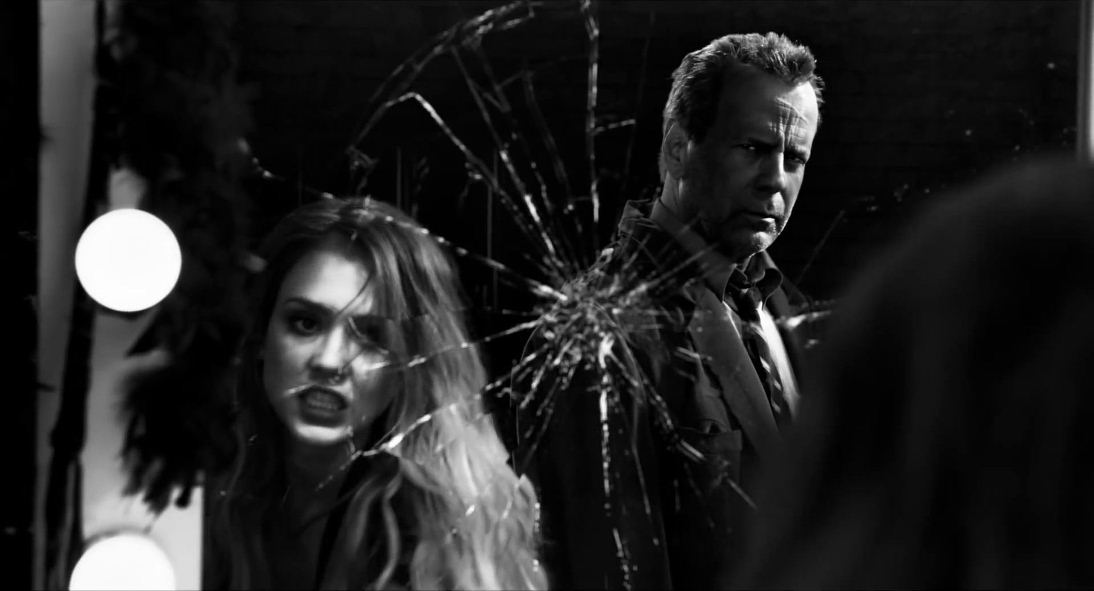In Frank Miller’s graphic novel series low-lifes and outlaws regularly do battle against creeps, sociopathic monsters, and even filthier souls in a perennially night-time scuzzy playhouse of crime, vice, and immorality. Sin City is a noir-world in the truest sense and a place seemingly devoid of churches and schools–though populated with plenty of casinos, strip clubs, and prisons. Even the long-serving senator is a thoroughly despicable and sinister villain; the grinning face of public-servant corruption. With the first installment of Sin City, director Robert Rodriguez turned these lurid and gruesome stories into a stunningly audacious movie. Cuddly it was not. The violence was bruising and shocking, but there was more to it. Alas, not so here. With this long-awaited sequel Rodriguez has made a picture that’s unable to rely on some of the best performances from the original and lacks its involving stories and vivid characterizations. At its worst, Sin City: A Dame to Kill For comes damn close to becoming a numbing spectacle of empty pornographic violence. Mostly, it’s just a big disappointment.
One of the most noticeable differences from the first movie is this has a screenwriting credit (the original was lifted directly from Frank Miller’s pages). Here Miller takes from his own series and pens two new fresh stories, “The Long Bad Night” and “Nancy’s Last Dance”. This is risky given that Miller’s artistic judgment is by no means unimpeachable: in the time since Sin City in 2005, he wrote and directed the nearly unwatchable The Spirit. One of that movie’s worst offenses was feeling like something of a retread. The thrill of the first Sin City was seeing the pulpy page literally brought to life in a way that felt bracingly new. A Dame to Kill For is weak enough to feel more like a stale photocopy.
The excitement of the series is undeniably there again though for the first couple scenes. We rejoin Marv, the misshapen and unloved Quasimodo of the Basin with a seemingly insatiable appetite for violence. When he happens upon some frat-jerks about burn a wino alive for sheer sick-pleasure, he chases them down demanding to know why one of them called him “Bernini Boy” (he has to steal a cop car and gets knocked out along the way). With the help of some friends in the neighborhood, Marv gets his answer and then some. In this city, it’s the closest thing to justice.
Three more stories follow. Unlike the first Sin City-which actually got better with each new story and its looping, interlocking format similar to Pulp Fiction-the episodes here (this tries to ape the lay-out of the first) get progressively poorer. In the second chapter Joseph Gordon-Levitt plays Johnny, a cocksure gambler who arrives in town ready to take on anyone. He plays Senator Roarke (Powers Booth) twice and wins both times. He suffers enormously for the nerve he shows, right down to having the distracting good-luck charm girl (Julia Garner) who accompanied him decapitated. Certain people you just don’t mess with and Booth again makes his crooked-evil politician into an impossibly repulsive character you just can’t help but love hating.
Josh Brolin takes over Clive Owen’s role from the original, playing Dwight McCarthy still hurting over Ava Lord (Eva Green), the dame who left him years earlier for a wealthier gent in the hulking middle chapter. When she calls him up asking for help, the head knows that trouble could be in store, but other parts of his body put up markedly less resistance. His initial reaction is right of course. When he uses the skills he’s developed as a private detective to peep in on her mansion and make sure she’s not in danger, she frames him for the murder of her husband before blasting him out the window with a gunshot to the face. For medical care Marv takes him to Old Town where the prostitutes led by Gail (Rosario Dawson) tend to his wounds and his face undergoes surgery that makes him barely recognizable. Together they plan revenge on her and the goons who guard her, and as these are Frank Miller’s characters, their recourse is most definitely not a lawsuit.
The final story is about Nancy Callahan, the once sweet girl who nearly met her end from the demented pedophiliac-killer clutch of Senator Roarke’s son and grew up to an exotic dancer who can only ever love the police officer who saved her (Bruce Willis as John Hartigan). Played again by Jessica Alba, this finds her four years after Hartigan’s death hitting rock bottom while plotting revenge on the Senator. It’s a distressingly on-autopilot finale that hardly tosses out any memorable moments beyond Alba’s Nancy cutting her own face as she hits rock bottom.
Wrongly accused by some as having the same attitudes its less sophisticated characters had, 2005’s Sin City had more going on than blood lust. There was a sense of moral grounding that’s absent here (no character expresses as Bruce Willis’s Hartigan did in the first that there are horrible things you should cover your eyes to guard you from seeing). There was also something of a feminist tilt to it, a palpable outrage at girls being mistreated by bad men. The message wasn’t just that you don’t hit or mistreat women: it was that when women are wronged they are strong and capable of standing up for themselves. Old Town’s army of prostitutes are no helpless damsels in distress; they are some of the most lethal and assertive people in the entire movie. They show up again here, obviously, but the most prominent woman of all is Green’s Ava as Eve, man’s eternal burden and curse; a cold-heartless femme fatale. Rodriguez does not miss an opportunity to gratuitously photograph the actress in the nude. It’s a real step backward.
A Dame to Kill For exists in a weird unspecified time sometimes separate and sometimes a part of the events in the first one. The appearance of Marv alone (who met a brutal, irreversible punishment in Sin City) is an early tip-off that things are a little loopy. That doesn’t mean every star from the original can return, and that’s one of the nagging problems. Brittany Murphy’s funny-fierce performance was amazing and her presence is dearly missed. Two of the other great performances were found in that same storyline: Benicio del Toro as an abusive-slimy cop and Clive Owen. Neither actor is cast in this sequel, though the ever dependable Bruce Willis does have a couple scenes as the ghost-guardian angel still looking after Nancy from beyond the grave.
As Marv, O’Rourke has another great go at the character, giving the sometimes repetitive dialogue punch and making bloodshed into wicked fun. Joseph-Gordon Levitt is fine too, displaying his usual smooth cocky ease. The always welcome Ray Liotta has a fine scene as a businessman having an affair with a hooker (a quick, effective Juno Temple) he’s about to kill to rid himself of and Christopher Lloyd is an even rarer presence still. Brolin’s gray, clenched performance by contrast is a real slog to get through.
The actor has been able to show in numerous previous roles a dynamic versatility bringing nuance to fairly straight roles, but this misses and falls short of Owen did with the same part . Rosario Dawson’s acting is spotty. The commanding Dennis Haysbert has been miscast as a human wrecking ball working for Ava. Eva Green, however, has been very appropriately chosen for the role. With her green eyes and cold, gorgeous features she always has exuded something of a wild and dangerous and perhaps villainous edge and this part makes ample use of all her features.
The visual allure and spectacle you look forward to are there, but only takes you so far (though admittedly probably even further if you catch it in 3-D). It’s hard not to be taken by the way this is a monochrome world where one of the only colors to appear is red, lighting up this dreary forever winter-night –a marker of immorality and danger. And the way that Rodriguez occasionally cuts during the many fight sequences to the figures being all white against a purely black backdrop, showing true adherence and reverence to the aesthetic of the source material is captivating.
It’s the abundant violence and the lack of anything behind it that’s less entrancing. There’s a visceral brutality to it that’s alarming at first-the pounding blows of faces bashed in, the impact of bullets striking and splattering flesh like a melon popping-that becomes deadening after a while (at one point Marv even rips a guy’s eyeball straight out of his head).
Josh Hartnett as a viciously handsome and seductive killer were the first and last scenes in Sin City and even though he’s not much of an actor, it gave the picture even more shape and style. This sequel ends with a scene that plays like a rough draft or place holder of something far juicier and satisfying. The dialogue feels flatter and more cardboard throughout (Miller does churn out some especially choice bad poetry: “I was up in mid-air. The pavement rushes up to give me a big sloppy kiss”).
In one of the stories a character more or less spontaneously snaps and kills a partner before ending his own life in a stroke of severely weird emotional illogic. A bad surprise, is still a surprise however, and more than what most of these stories can muster up, particularly the brainless final chapter. Sin City: A Dame to Kill For isn’t ever boring, but it lacks the sustained thrills of its predecessor, relying on what feels like cheaper, lazier second-rate story lines. It’s neither a crime nor a sin. The sting felt here is from a crushing let down.

